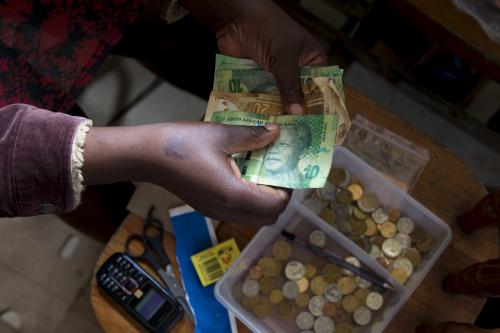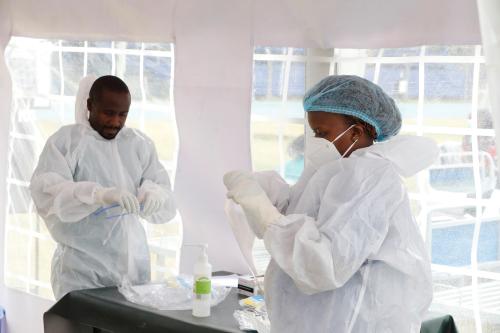Earlier this month, the International Monetary Fund (IMF) launched its spring Regional Economic Outlook report for sub-Saharan Africa, in which it explores COVID-19’s impact on debt accumulation in sub-Saharan Africa, among other themes. According to the report, public debt in the region has increased to almost 58 percent of its GDP, the highest it has been in 20 years.
According to the report, , up from six countries just seven years ago (Figure 1). Notably, one-quarter of the region’s GDP comes from these 17 countries, and eight of them are considered fragile states.
Figure 1. Sub-Saharan Africa: Debt risk status for low-income developing countries eligible for the IMF’s Poverty Reduction and Growth Trust, 2014-20
 Source: International Monetary Fund. 2021. “Regional economic outlook. Sub Saharan Africa: navigating a long pandemic.” (April), International Monetary Fund, Washington, D.C.
Source: International Monetary Fund. 2021. “Regional economic outlook. Sub Saharan Africa: navigating a long pandemic.” (April), International Monetary Fund, Washington, D.C.
As seen in the figure, while the number of countries at low risk of debt distress dropped during the pandemic, the number of countries at risk for moderate and high debt distress increased. This rise is due to increased spending—necessary for combating both the health implications and the fall in economic activity under the COVID-19 pandemic, write the authors. (For more on the balance between debt management and spending in a crisis, see Brahima S. Coulibaly’s Foresight Africa 2021 viewpoint.)
To address the challenge, the authors call for fiscal consolidation to help improve the debt footing in the region to one that is more sustainable—a recommendation they offered in the 2017 edition of the same report. Fiscal consolidation—periods of fiscal adjustment during which spending cuts are made or non-commodity revenue is mobilized to improve fiscal positions—is important when these countries are creating plans to move toward sustainable recovery post-COVID-19. They also write that the main challenge to fiscal consolidation would be creating more fiscal space. More specifically, they suggest that, depending on circumstances, governments looking to expand their fiscal space can look to tax policies that (1) increase the progressivity and coverage of personal income taxes, (2) eliminate distortionary corporate income tax exemptions and incentives, (3) increase the role of property and environmental taxes, and (4) broaden the value-added tax (VAT) base. (For more on strategies for effective domestic resource mobilization, see the policy brief, “Mobilization of tax revenues in Africa: State of play and policy options.”)
The IMF also highlights that transparency and good governance are key to the region’s economic recovery. With the influx of loans and development funds, it is important for governments to be transparent and ensure that the funds given are going to the people who need it most. Already, they write, more than 60 percent of the countries have committed to publishing procurement information, almost 80 percent have committed to publishing information on beneficial ownerships, and all countries have committed to audits. (For more on stemming illicit financial flows in the region, see “New trends in illicit financial flows from Africa.”)
As for the future of debt relief, the IMF states that some countries in Africa will find themselves facing a difficult choice between debt repayment and essential health obligations that can be critical in a pandemic and afterward. The report suggests that as countries reach debt amounts that exceed their capacity to pay back, creditors should quickly agree on terms of debt treatment. (For more on calls for creditors to offer debt relief in the face of COVID-19, see “The unfinished agenda of financing Africa’s COVID-19 response.”)
For more on debt in Africa, especially in the face of the COVID-19 crisis, check out these resources:
- “From stimulus to debt: The case of South Africa” by Haroon Bhorat and Gracelin Baskaran
- “Fiscal and debt sustainability in Africa” by Kapil Kapoor, et al.
- “Africa needs debt relief to fight COVID-19” by Ngozi Okonjo-Iweala, et al.
- “Debt sustainability and financing for development: A key post-COVID challenge” by Brahima S. Coulibaly
- “COVID-19 crisis: G-20 and debt sustainability in sub-Saharan Africa” by Kathrin Berensmann, Aloysius Ordu, and Lemma Senbet
- “China’s debt relief for Africa: Emerging deliberations” by Yun Sun







Commentary
Figure of the Week: COVID-19’s impact on debt risks in sub-Saharan Africa
April 28, 2021